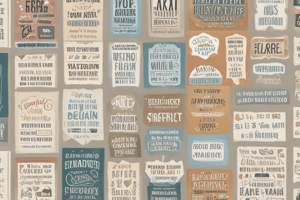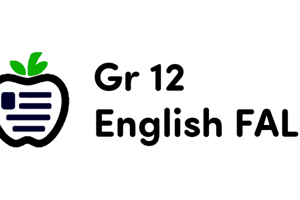Podcast
Questions and Answers
Which speech function primarily aims to establish social interaction?
Which speech function primarily aims to establish social interaction?
- Phatic (correct)
- Directive
- Metalinguistic
- Expressive
What type of speech function is used when a speaker expresses their feelings?
What type of speech function is used when a speaker expresses their feelings?
- Expressive (correct)
- Referential
- Commissives
- Directive
Which of the following best defines directives?
Which of the following best defines directives?
- Utterances that provide information
- Utterances that focus on aesthetic features of language
- Utterances that comment on language itself
- Utterances aimed at getting someone to do something (correct)
What determines the form of a directive in communication?
What determines the form of a directive in communication?
Which speech function is exemplified by marriage vows or declarations of war?
Which speech function is exemplified by marriage vows or declarations of war?
How do imperatives function differently between friends and superiors?
How do imperatives function differently between friends and superiors?
Which of these is NOT a function of speech described in the content?
Which of these is NOT a function of speech described in the content?
What is common about the directive function regarding formal situations?
What is common about the directive function regarding formal situations?
How do male doctors typically express directives compared to female doctors?
How do male doctors typically express directives compared to female doctors?
What factor can influence the way directives are expressed in communication?
What factor can influence the way directives are expressed in communication?
In what context might all directives be expressed as imperatives, according to the content?
In what context might all directives be expressed as imperatives, according to the content?
Why is politeness considered complex in communication?
Why is politeness considered complex in communication?
What can be a consequence of using inappropriate linguistic choices?
What can be a consequence of using inappropriate linguistic choices?
What is one of the macro-level social categories that can be constructed through linguistic features?
What is one of the macro-level social categories that can be constructed through linguistic features?
Which form of address is often used to reflect politeness in social interactions?
Which form of address is often used to reflect politeness in social interactions?
What aspect of identity construction can influence the way language is used?
What aspect of identity construction can influence the way language is used?
Which characteristic primarily defines positive politeness?
Which characteristic primarily defines positive politeness?
In terms of address forms in Britain, what is typically used in transactional relationships?
In terms of address forms in Britain, what is typically used in transactional relationships?
How do adults typically address children in terms of formality?
How do adults typically address children in terms of formality?
The usage of familiarizers like 'mate' or 'dude' depends on what factor?
The usage of familiarizers like 'mate' or 'dude' depends on what factor?
Which of the following best describes the changes in norms of address usage over time?
Which of the following best describes the changes in norms of address usage over time?
In many Asian societies, what remains a significant factor in terms of politeness?
In many Asian societies, what remains a significant factor in terms of politeness?
What is a common method of greeting in Māori culture?
What is a common method of greeting in Māori culture?
Which relationship dynamics create a conflict in norms as outlined?
Which relationship dynamics create a conflict in norms as outlined?
What common issue can arise due to different norms and expectations of politeness?
What common issue can arise due to different norms and expectations of politeness?
In which culture is it considered impolite to accept food on the first offer?
In which culture is it considered impolite to accept food on the first offer?
What is the dominant characteristic of social interactions in the UK regarding polite refusals?
What is the dominant characteristic of social interactions in the UK regarding polite refusals?
Which social factors might influence the choice of language when asking someone to remain silent?
Which social factors might influence the choice of language when asking someone to remain silent?
What is an example of positively polite behavior across many cultures?
What is an example of positively polite behavior across many cultures?
How does the concept of privacy manifest in countries like Britain and New Zealand when it comes to social interactions?
How does the concept of privacy manifest in countries like Britain and New Zealand when it comes to social interactions?
What aspect of cultural context is essential to understand when engaging in cross-cultural communication?
What aspect of cultural context is essential to understand when engaging in cross-cultural communication?
What is a potential consequence of not understanding the cultural context during social interactions?
What is a potential consequence of not understanding the cultural context during social interactions?
Flashcards
Expressive function of speech
Expressive function of speech
Utterances used to express the speaker's personal feelings, opinions, or beliefs.
Directive function of speech
Directive function of speech
Utterances aimed at getting someone to perform an action.
Referential function of speech
Referential function of speech
Utterances that focus on providing information and factual statements.
Metalinguistic function of speech
Metalinguistic function of speech
Signup and view all the flashcards
Phatic function of speech
Phatic function of speech
Signup and view all the flashcards
Imperative directive
Imperative directive
Signup and view all the flashcards
Interrogative directive
Interrogative directive
Signup and view all the flashcards
Declarative directive
Declarative directive
Signup and view all the flashcards
Positive politeness
Positive politeness
Signup and view all the flashcards
Negative politeness
Negative politeness
Signup and view all the flashcards
Address Forms
Address Forms
Signup and view all the flashcards
Mutual TLN
Mutual TLN
Signup and view all the flashcards
Mutual FN
Mutual FN
Signup and view all the flashcards
Familiarizers
Familiarizers
Signup and view all the flashcards
Status-based Address
Status-based Address
Signup and view all the flashcards
Conflict of Norms
Conflict of Norms
Signup and view all the flashcards
Politeness in directives
Politeness in directives
Signup and view all the flashcards
Indirect directive
Indirect directive
Signup and view all the flashcards
Using "we" in directives
Using "we" in directives
Signup and view all the flashcards
Power and directives
Power and directives
Signup and view all the flashcards
Cultural impact on politeness
Cultural impact on politeness
Signup and view all the flashcards
Phatic function
Phatic function
Signup and view all the flashcards
Identity construction in communication
Identity construction in communication
Signup and view all the flashcards
Online identity construction
Online identity construction
Signup and view all the flashcards
Cultural Context and Meaning
Cultural Context and Meaning
Signup and view all the flashcards
Linguistic Politeness
Linguistic Politeness
Signup and view all the flashcards
Sociolinguistic Norms for Acceptance/Refusal
Sociolinguistic Norms for Acceptance/Refusal
Signup and view all the flashcards
Greeting's Affective Function
Greeting's Affective Function
Signup and view all the flashcards
Culture-Specific Greetings
Culture-Specific Greetings
Signup and view all the flashcards
Factors Affecting Directives for Silence
Factors Affecting Directives for Silence
Signup and view all the flashcards
Cross-Cultural Communication
Cross-Cultural Communication
Signup and view all the flashcards
Misunderstandings in Cross-Cultural Communication
Misunderstandings in Cross-Cultural Communication
Signup and view all the flashcards
Study Notes
Speech Functions, Politeness, and Cross-Cultural Communication
-
Speech functions encompass various categories relating to expression, direction, reference, and more.
-
Greetings can function as summons or establish interaction levels.
-
Expressive utterances convey speaker feelings.
-
Directive utterances aim to influence others.
-
Referential utterances provide information.
-
Metalinguistic utterances comment on language itself.
-
Poetic utterances highlight aesthetic language features.
-
Phatic utterances build solidarity, rapport, and empathy.
-
Directives - verbal requests or commands.
- Vary in strength, from suggestions to commands.
- Expressed as imperatives or interrogatives/declaratives.
- Politeness varies with social factors like distance, status, and context.
- Gender and age may affect directive choice.
-
Directives, as a functional category, include varied strength.
-
Identity Construction is influenced by social settings, roles, goals, responses to others, macro social categories, linguistic features, interactional elements, and local identity categories.
-
Identity construction differs online.
Politeness and Address Forms
-
Politeness is complex, involving understanding language, social, and cultural factors.
-
Politeness contributes to harmony and avoids conflict.
-
Summons initiate interactions when someone needs attention.
-
Greetings can have a phatic function.
-
Linguistic devices and discourse strategies display politeness.
-
2 types of politeness
- Positive Politeness: emphasizes solidarity and shared attitudes/values.
- Negative Politeness: emphasizes social distance and power relations.
-
Address forms in different contexts reflect different power structures and social norms.
-
In British contexts, mutual use of TLN is common amongst equals, while downwards, there is a greater respect to superiors with TLN or kin terms being used.
-
In some cultures, using first names (FN) might be a sign of rapport or familiarity for people who are not so close. However, this may be deemed impolite in some cultures.
Linguistic Politeness in Different Cultures
-
Cross-cultural communication involves understanding different cultural assumptions.
-
Different cultures have different speech norms related to appropriate topics in conversations.
-
Certain topics might be considered taboo or unsuitable to discuss in some cultures.
-
In some cultures, a degree of vagueness in communication is less frowned upon, compared to others where directness and clarity are prioritized in conversations.
-
Sociolinguistic norms affect polite acceptance and refusal of things like offers of food.
-
Greetings are culture-specific rituals with varying degrees of formality.
-
Complex procedures can govern elements of greetings.
-
Addressing superiors or those in positions of higher authority should be done with politeness and respect.
-
Norms of address usage can change through time.
-
Status and solidarity are important considerations for communication.
Homework
- Complete Class Discussion tasks.
- Read Chapter 12.
Studying That Suits You
Use AI to generate personalized quizzes and flashcards to suit your learning preferences.




